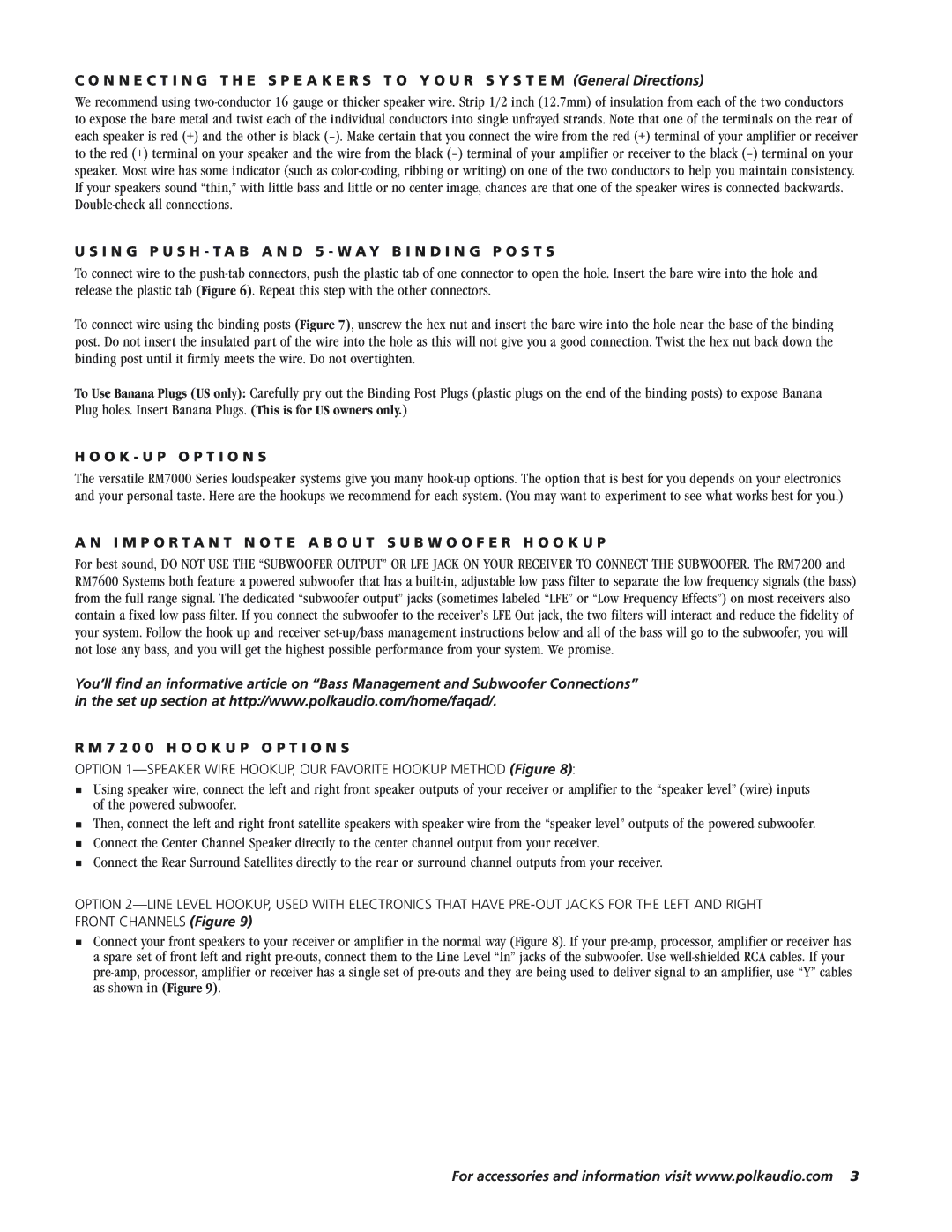C O N N E C T I N G T H E S P E A K E R S T O Y O U R S Y S T E M (General Directions)
We recommend using two-conductor 16 gauge or thicker speaker wire. Strip 1/2 inch (12.7mm) of insulation from each of the two conductors to expose the bare metal and twist each of the individual conductors into single unfrayed strands. Note that one of the terminals on the rear of each speaker is red (+) and the other is black (–). Make certain that you connect the wire from the red (+) terminal of your amplifier or receiver to the red (+) terminal on your speaker and the wire from the black (–) terminal of your amplifier or receiver to the black (–) terminal on your speaker. Most wire has some indicator (such as color-coding, ribbing or writing) on one of the two conductors to help you maintain consistency. If your speakers sound “thin,” with little bass and little or no center image, chances are that one of the speaker wires is connected backwards. Double-check all connections.
U S I N G P U S H - T A B A N D 5 - W A Y B I N D I N G P O S T S
To connect wire to the push-tab connectors, push the plastic tab of one connector to open the hole. Insert the bare wire into the hole and release the plastic tab (Figure 6). Repeat this step with the other connectors.
To connect wire using the binding posts (Figure 7), unscrew the hex nut and insert the bare wire into the hole near the base of the binding post. Do not insert the insulated part of the wire into the hole as this will not give you a good connection. Twist the hex nut back down the binding post until it firmly meets the wire. Do not overtighten.
To Use Banana Plugs (US only): Carefully pry out the Binding Post Plugs (plastic plugs on the end of the binding posts) to expose Banana Plug holes. Insert Banana Plugs. (This is for US owners only.)
H O O K - U P O P T I O N S
The versatile RM7000 Series loudspeaker systems give you many hook-up options. The option that is best for you depends on your electronics and your personal taste. Here are the hookups we recommend for each system. (You may want to experiment to see what works best for you.)
A N I M P O R T A N T N O T E A B O U T S U B W O O F E R H O O K U P
For best sound, DO NOT USE THE “SUBWOOFER OUTPUT” OR LFE JACK ON YOUR RECEIVER TO CONNECT THE SUBWOOFER. The RM7200 and RM7600 Systems both feature a powered subwoofer that has a built-in, adjustable low pass filter to separate the low frequency signals (the bass) from the full range signal. The dedicated “subwoofer output” jacks (sometimes labeled “LFE” or “Low Frequency Effects”) on most receivers also contain a fixed low pass filter. If you connect the subwoofer to the receiver’s LFE Out jack, the two filters will interact and reduce the fidelity of your system. Follow the hook up and receiver set-up/bass management instructions below and all of the bass will go to the subwoofer, you will not lose any bass, and you will get the highest possible performance from your system. We promise.
You’ll find an informative article on “Bass Management and Subwoofer Connections” in the set up section at http://www.polkaudio.com/home/faqad/.
R M 7 2 0 0 H O O K U P O P T I O N S
OPTION 1—SPEAKER WIRE HOOKUP, OUR FAVORITE HOOKUP METHOD (Figure 8):
Using speaker wire, connect the left and right front speaker outputs of your receiver or amplifier to the “speaker level” (wire) inputs of the powered subwoofer.
Then, connect the left and right front satellite speakers with speaker wire from the “speaker level” outputs of the powered subwoofer.
Connect the Center Channel Speaker directly to the center channel output from your receiver.
Connect the Rear Surround Satellites directly to the rear or surround channel outputs from your receiver.
OPTION 2—LINE LEVEL HOOKUP, USED WITH ELECTRONICS THAT HAVE PRE-OUT JACKS FOR THE LEFT AND RIGHT FRONT CHANNELS (Figure 9)
Connect your front speakers to your receiver or amplifier in the normal way (Figure 8). If your pre-amp, processor, amplifier or receiver has a spare set of front left and right pre-outs, connect them to the Line Level “In” jacks of the subwoofer. Use well-shielded RCA cables. If your pre-amp, processor, amplifier or receiver has a single set of pre-outs and they are being used to deliver signal to an amplifier, use “Y” cables as shown in (Figure 9).
